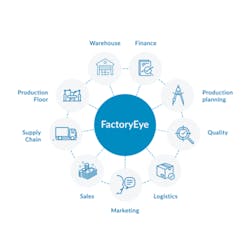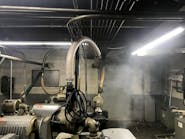Manufacturers have so many pressing matters on their agenda that the transition to Industry 4.0 can be difficult to include in the budget — both monetarily and mentally. This means that smart manufacturing has stagnated on project lists for many mid-sized manufacturers since planning next steps for digital transformation takes valuable company resources. This makes Industry 4.0 seem unattainable when manufacturers are busy and working in a relatively lean labor environment. However, by taking carefully measured steps manufacturers can move incrementally toward digital transformation in their business and apply technology that is now available to improve efficiencies on the production floor. For a successful Industry 4.0 transition, mid-sized manufacturers need to have supportive team members to be part of the solution and a realistic timeline for measuring the return on investment (ROI).
The challenges of supporting the varied needs of modern-day consumers and then the COVID-19 pandemic highlighted the benefits that manufacturers could yield from digital transformation. Modern day consumers use the internet to compare the price and quality of products prior to purchase. So, manufacturers of all sizes had to make their processes quicker while keeping a high quality product with a low cost per unit. The pandemic highlighted how fragile the supply chain can be during a worldwide disruption as the need for some items skyrocketed, and plummeted for others. Unexpected employee outages also impacted processing speeds for many manufacturers and technology needed to be accessible for remote workers. If only one operator has historical knowledge on typical machine issues then this can hinder the production process if they leave without notice. Granted, there is a lot more gray area that goes into production being efficient than just downtime and uptime for mid-sized manufacturers. The data needs to allow for some nuances in measurement and implementation.
While the technology behind digital transformation is not new, most Industry 4.0 solutions do not consider the needs of mid-sized manufacturers and focus exclusively on larger operations. In the past, it took fewer resources for manufacturers to support traditional methods and many executives disregarded digital solutions. Manufacturers pushed their resources into physical automation on the plant floor without considering the benefit of gaining insight into the processing data. This means some manufacturers are still capturing machine data with pen and paper or in an Excel sheet without advanced analytics. Others, meanwhile, are capturing data into data silos where important information is restricted, not only in technology and systems, but also for people in the process. It can be difficult to make rapid changes with a siloed infrastructure since information cannot flow from one system to another. If manufacturers want to make decisions on the fly, they have to integrate data transparency for everyone. So, in this new post-pandemic landscape that has been outlined, what are the best steps for mid-sized manufacturers wanting digital transformation?
1. Take small slices
Instead of looking at the Industry 4.0 transition as an insurmountable wall, mid-size manufacturers should consider the most beneficial first step for the factory floor. A full pause of processing and overhauling costly equipment is no longer needed for a transition to Industry 4.0. Newer machines have sensors built in, but older machines can have sensors attached to them that will capture real-time data to increase efficiency on the floor. These sensors can measure vibration, temperature cycle time and many other variables of the machine to capture key performance indicators (KPIs). Since staffing can be so challenging, the intelligence from the sensors provides advanced notice of any machine issues so the correct operator can be there to help. Small changes in the most-needed areas will prove the benefits of digital transformation so that these changes can be noticed, ideally, even on some levels, in 90 days or less. For digitizing the processing floor, a meeting should be set up with the operators involved in the manual data capture to determine the most efficient way to modernize with small changes. If manufacturers make it more difficult than putting information in a notebook, it may be too complicated for the operator. The user interface should make sense in a production floor environment to encourage adoption from an operator level. The operator's looking for ease of use and from an executive perspective, manufacturers can get all the data they want, but if it is not actionable and meaningful to the operation, this tremendously decreases the value it can drive.
2. Determine your ‘knight’ of Industry 4.0
Mid-sized manufacturers are so busy they need to find someone who can focus on the Industry 4.0 transition each step of the way. This person should be organized, thoughtful and intimately familiar with the effects that Industry 4.0 would have on the production floor. With modern technology, it is not necessary to hire multiple consultants to safeguard the process. This person at the organization should know at what point the supervisors should be automatically alerted for a missed deliverable or if they did not receive a response from the supplier for low inventory. Finding this person can greatly help since the mid-level managers need to focus on actually allocating resources and making management decisions. Industry 4.0 is all about reducing cost and increasing efficiencies so having a single person focus on this process is beneficial.
3. Outline the ROI
Digital transformation helps by collecting real-time data from existing machinery and operational systems and transforming it into actionable intelligence for immediate results and continuous improvement in the manufacturing process. For proven ROI, manufacturers need to control internal endeavors and the storing of inventory, and they must properly plan ahead to optimize the learning process for cost reductions. Many mid-sized manufacturers are still manually recording their production data which leaves opportunities for mistakes and missing data. Having this information captured from a machine sensor would free up the operator capturing these numbers for other tasks. It is imperative that the employees themselves feel that transitioning to Industry 4.0 makes their jobs easier. The incorporation of sensors on existing machinery gives factories the possibility to collect more data without changing the existing systems. As an added bonus, advanced analytics tools that identify specific problems can make real-time decisions for processing flow. This is beneficial since mid-sized manufacturers can have hundreds or thousands of SKU’s being manufactured simultaneously or preparing for shipment. Once the computer knows what to look for it can make manufacturing decisions based on actual, accurate information. The ability to get the information and artificial intelligence (AI) to do predictive maintenance is going to be one of the keys to moving forward for continuous improvement.
Digital transformation can help manufacturers gain control of their business performance by fully integrating information flow from order to delivery. With each passing year, modern machinery is getting better at producing and making data available. By increasing visibility on the shop floor, manufacturers can gain real-time insights into business operational processes and KPI’s. Some solutions even allow for seamless connectivity of key information systems like ERP, MES, PLM and QMS, which enables optimization of production planning, scheduling, procurement and logistics. However, the updated smart manufacturing systems that are added or changed in the business have to be integrated into the big picture to engage the floor staff and machine operators. If they are not engaged, the team will not be able to gain enough insights to determine the effects on processing, which can be discouraging. For mid-sized manufacturers, keeping the correct application of technology efficient is key. The data needs to be integrated into the full production overview to help manufacturers understand how digital transformation is helping their operations. The mid-sized manufacturers that embrace smart manufacturing will lead the way as key players in the modernization of processing.
As President of FactoryEye by Magic Software Enterprises, Terri Ghio is responsible for the development and implementation of FactoryEye’s overall corporate strategy, business development and strategic partnerships. Ghio has been an invaluable resource in expanding on Magic’s global success and building Magic’s Industry 4.0 solution for mid-sized manufacturers, FactoryEye.




